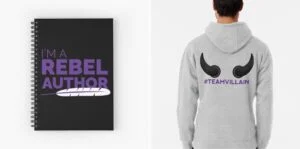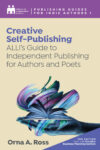 This is part three in ALLi's Self-Publishing Money Basics series. If you’ve been following along, you’ll have already considered how to embrace a positive money mindset, and learnt the key financial terms to get you started on your business journey, and now you'll be ready for more detail to help with money management for your author business.
This is part three in ALLi's Self-Publishing Money Basics series. If you’ve been following along, you’ll have already considered how to embrace a positive money mindset, and learnt the key financial terms to get you started on your business journey, and now you'll be ready for more detail to help with money management for your author business.
This post shares three of the key principles from ALLi’s Creative Self-Publishing Guide: from how to pay yourself first, to choosing the right business model for you, and considering your income streams. The full guide takes you through every step of the self-publishing process with Orna Ross, ALLi’s Director, and is available on our bookstore. Members enjoy free access to the ebook.

Photo by micheile dot com on Unsplash
Key principle one: pay yourself first (PYF)
If you take away just one principle from this post this is perhaps the most important of all. Ensure that you, the author, take an income from your work: no matter how little you are earning, you need to pay yourself first.
ALLi always advises you start as you mean to go on, and all your writing income must enter a separate account from your own personal account. So, if you haven’t yet divided up your business and personal bank accounts, now’s the time to do it.
It can be easy to think ‘I’ll pay myself when I make enough money’, but be warned, as an author your business expenses can ever expand to fill the money available.
So what does this mean in practise? The easiest way to get keep on track is to divide your money as it arrives into your business account. Take care of tax obligations of course and then divert some of the remaining profit into your personal bank account as your salary immediately before considering anything else beyond your usual business expenses.
How do I know what is profit?
The formula for working out your business profits is usually expressed as:
Income – expenses & taxes = profit
It’s from this profit that you take a salary, dividends, and pension.
But expenses can keep increasing and for authors that means there often is no profit, and many times even a loss.
Turn the sum around
Orna suggests you can begin by turning the formula around. She says: ‘It might seem to you that there’s no difference (…) but everything changes when you think about ensuring there’s enough profit to pay yourself first.’
To be commercially successful, you need to have in your head a clear intention to make a profit so that you can pay yourself. Your number one goal, ahead of investing in more areas of your business, is to pay yourself. That’s what a successful business looks like.
ALLi recommends creating four accounts to deal with each of the costs associated with the Pay Yourself First model.
- Your Business (Revenue and Expenses or RevEX) Account: This is where your payments go in and from which you then pay others and your own accounts.
- Your Salary Account: This is usually your existing personal account which you will use to pay yourself. The amount will vary depending on your circumstances, such as the size of your business and whether you are writing full or part time.
- Tax Hold Account: This is a savings account where you keep your tax only.
- Profit Hold Account: This is a savings account where you keep any remaining profit above and beyond your salary (Dividends) only. As your business grows you can either use this money to reinvest or release dividends to yourself.
Allocate a percentage to each account. And when you receive your revenue distribute it based on that percentage to each account, no matter how large or small it is (even if it is £1). You should do this process regularly, ALLi recommends twice a month.
Key principle two: choose a business model that’s right for you
To run any commercially successful creative enterprise you need to shape your skills, talents, services, and expertise into something you can sell – this is your ‘product’. But how you get that product into your customers’ hands can make a big difference in terms of your business planning and money management.
Different approaches will suit different authors, and here we outline five models to consider:
-
Exclusive Self-Publishing Model
Here you self-publish through one distributor only. This is often used by popular genre authors (Romance, Crime, Fantasy etc.) who may favour the convenience and perks of exclusivity offered by sites such as Amazon, which offers KDP, Kindle Unlimited for ebooks and Amazon ACX for audiobooks. This requires a fast-and-often approach to publishing, keeping up to date with the Amazon algorithms to stay strong against your competitors.
Other authors in this category may go exclusive with one ‘aggregator’ such as Draft2Digital, PublishDrive, StreetLib etc. who offer a service that lets you upload your manuscript in one place, and then the provider distributes your work to multiple channels. While others may only sell through their own website and channels. The main advantage to this model is simplicity. However, you are potentially making yourself vulnerable with ‘all your eggs in one basket’ and may be missing out on wider reach.
A few authors also sell exclusively from their own author website especially providing their superfans exclusive content or special edition books.
-
Wide Self-Publishing Model
Again these authors build their business on their books primarily, but distribute across a range of sales platforms, rather than limiting to just one. This approach aims to reach as many readers as possible, in as many formats as possible, and can include platforms such as: Kobo, Google Play, IngramSpark and Apple Books. Authors also sell their books directly from their author website. Many authors who publish wide also use an aggregator to distribute even wider globally to reach hundreds of other outlets.
The advantage is the wide reader reach and the spread of risk by offering your books available in a range of places. Even if one platform struggles or even closes your account, you still have the other platforms to fall back on. However this model can also be very time consuming to manage including income and outgoings across a range of platforms and services which can complicate your money management activity.
-
Creator Model
The Creator Economy is the term given to the section of the economy where consumers directly fund the work of artist, such as musicians, film-makes and even authors. In publishing this can mean selling directly to readers, and not just your books, but various related products, for example subscriptions, memberships, paid video, or audio content, and even patronage through platforms such as Patreon. Some of the authors in this business model also offer services beyond their direct writing products and could be seen as ‘creative entrepreneurs’.
But, note that this is different to being a freelancer alongside your writing. All the activities carried out by these authors still add to their mission as a writer and is often based on offering their core followers wider content. In this model, customers become supporters or patrons for your creative work, and this can offer more dependable income. One watch-out is that reader expectation can then be very high, so being able to manage and deliver consistently to that promise is key.
-
Rights Licensing Model
In this model, as well as publishing your own books, an author licenses publishing rights to a third-party rights buyer. Limiting the format, terms, and territory can maximise your income and still give you control over your chosen formats.
An advantage of this model is that your licensing partners can bring expertise and new opportunities to expand your reach. The disadvantage is that you will need to spend time pitching, negotiating, and managing your contract agreements carefully, and (as outlined further below), without the right advice, you can slip up and sell more than you bargained for.
-
Publisher model
Authors employing this model not only publish their books but those of other authors too, becoming a third-party publisher themselves. They may work like a traditional publisher (licensing authors’ rights and paying royalties), or a hybrid publisher (charging for publishing services). These authors usually set up an imprint name, brand, and website, and use their experience to take other authors through the publishing process.
The upside of this model is the chance to work in the trade, however, the downside can be the management time and responsibility required for other authors’ work, money, and careers.
If you’ve heard these five options, and still aren’t sure where you sit, or where you want to sit in the future, try this. Ask yourself: ‘When I hear about an indie author’s success that truly inspires me, which model are they using?’ And then consider: ‘Does that model suit my life routine, lifestyle, and goals?’
Asking yourself these sorts of probing questions to see how you respond and what brings you excitement and inspiration will bring you closer to identifying what sort author business you want to grow.

Example Author branding used on merchandise, Sacha Black.
Key principle three: consider your income streams
We include this principle here as you may have thus far only seen yourself as an author. You write books and you sell those books, that is your product. This focused approach can work perfectly for many authors, but you may want to consider if diversifying what you offer could benefit your business and increase your sales and overall revenue.
Offering a range of income streams can build further stability to your business and ensure you can refocus on one product when another – such as your books – may have a quiet period.
We know that our ALLi Members produce and market a range of complementary products alongside their books, and we’ve included a list of them here for your consideration as you develop your business plan and consider your income streams. What could you add to your products and services?
Products:
- Books – Ebooks, audiobooks, POD books and/or volume print runs
- Book Box sets – digital and/or print
- Crowdfunded products
- Memberships or subscriptions for readers – on your own website or through platforms like Patreon
- Merchandise linked to your book, such as workbooks or soft toys (self-commissioned)
- Translations of your book (self-commissioned)
Services:
- Freelancing – including writing or copywriting
- Journalism – print, podcasting, radio, TV etc.
- Publishing Services – editing, formatting, design etc.
- Referrals/affiliate marketing
- Speaking and appearances
- Sponsorship or other influencer income
- Teaching writing or publishing craft to other authors
Licensing:
- Book publishing rights at home or overseas
- Broadcasting rights (TV/film)
- Dramatic rights (theatre/radio plays)
- Merchandising rights
- Translation rights
One big watch-out on those final options for licensing – you must always be extremely cautious when selling any rights. Be specific and ensure you fully understand the rights you are licensing, including avoiding vague terms such as ‘digital rights’. Be wary of contracts that aim to restrict future formats without fully understanding them. Ideally you should garner legal advice before signing any contract. ALLi Members can request advice from us in advance of signing.
Find out more
 For more information about Selective Rights Licensing and how to manage it, including an introduction to copyright law and your moral rights, take a look at this ALLi blog post: Selective Rights Licensing for Indie Authors
For more information about Selective Rights Licensing and how to manage it, including an introduction to copyright law and your moral rights, take a look at this ALLi blog post: Selective Rights Licensing for Indie Authors
 To learn more about the full process of self-publishing, Creative Self-Publishing: ALLi’s Guide to Independent Publishing for Authors and Poets is available from the ALLi bookstore. ALLi members enjoy free access as part of their membership. In an engaging, easy-to-read format, you’ll learn:
To learn more about the full process of self-publishing, Creative Self-Publishing: ALLi’s Guide to Independent Publishing for Authors and Poets is available from the ALLi bookstore. ALLi members enjoy free access as part of their membership. In an engaging, easy-to-read format, you’ll learn:
- Which creative practices and business models successful authors use today
- Where you fit in the history of authorship and self-publishing
- How to overcome publishing resistance and block by fostering creative flow.
- Where to find your ideal readers and how to ensure they find your books
- A proven planning method that marries your passion, mission and purpose as writer and publisher.






Useful tips will make life easier.
It’s good information!